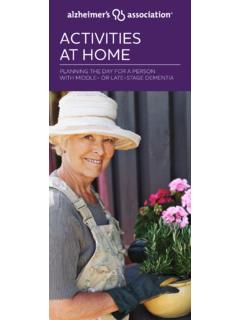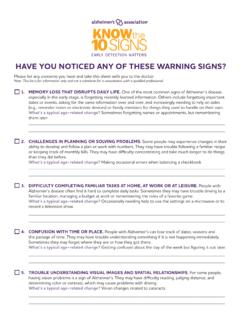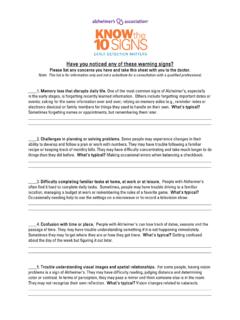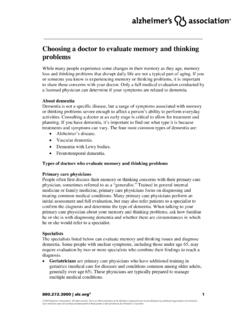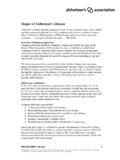Transcription of Personal Care - Alzheimer's Association
1 Personal CAREASSISTING A PERSON WITH MIDDLE- OR LATE-STAGE DEMENTIA WITH DAILY NEEDSDAILY care FOR A PERSON WITH MIDDLE- OR LATE-STAGE alzheimer SPeople with dementia slowly become less able to take care of themselves. At first, a person may need only prompting or a little help, but eventually caregivers will become responsible for all Personal of independence and privacy can be very difficult. Being aware of the person s reactions, abilities and fears can help both the person with the disease and the caregiver have a better CONSIDERATIONS FOR ASSISTING WITH Personal CARE1. Be flexible adapt to the person s Help the person be as independent as Guide by using easy, step-by-step Speak in short, simple Avoid rushing the person through a Encourage, reassure and offer Watch for nonverbal Experiment with new Consider using different Be patient, understanding and Bathing.
2 Dental care .. Eating .. 5. Toileting .. TIPS FOR BATH I N GBathing is often the most difficult Personal care activity that caregivers face. Because it is such an intimate experience, people with dementia may perceive it as unpleasant or intrusive. They may show their discomfort or distress by screaming, crying, resisting or hitting. Such behavior may occur because the person doesn t remember why they have to bathe or doesn t have the patience to endure unpleasant parts of the task, such as lack of modesty, being cold or experiencing other ASSIST:Prepare the bathroom in advanceGather the supplies for bathing beforehand, like towels, washcloths, shampoo and soap, so that you and the person can focus on bathing. Check the room temperature to make sure it s not too the bathroom safeTo prevent falls, install grab bars on the wall and tub edge.
3 Place non-slip mats on floors. Use a tub bench or bath chair that can be adjusted to different heights. Test the water temperature in advance to prevent burns. Never leave the person alone in the the person feel in controlInvolve and coach the person through each step of the process. You may need to experiment to find out if the person prefers tub baths or showers. Also, consider what time of day seems to be best for the the person in the processBe sure the person has a role in the process. For example, have the person hold a washcloth or shampoo the person s dignitySome people may be self-conscious about being naked. Letting the person hold a towel in front of his or her body, in and out of the shower or tub, may help ease t worry about the frequency of bathingIt may not be necessary for individuals to bathe every day.
4 Sponge baths with a washcloth can be effective between showers or gentleThe person s skin may be very sensitive. Avoid scrubbing and pat dry instead of rubbing. You may want to install a hand-held shower to make it easier to wash hard-to-reach flexibleWashing the person s hair may be the most difficult task. Ask the person to hold a washcloth over their eyes to avoid getting soap in TIPS FOR DENTAL CAREP roper care of the mouth and teeth can help prevent eating difficulties, digestive problems and extensive dental procedures down the road. However, brushing can be challenging because a person with dementia may forget the importance of oral ASSIST:Provide short, simple instructions Brush your teeth by itself may not be specific enough. Break down each step by saying: Hold your toothbrush.
5 Put paste on the brush. Then, Brush your teeth with the toothbrush. Use a watch-me or hand-over-hand techniqueShow the person how to brush his or her teeth by brushing your own. Or put your hand over the person s hand, gently guiding the daily oral careBrush teeth or dentures after each meal. Remove and clean dentures every night. Very gently brush the person s gums, tongue and roof of the mouth. Try to floss regularly. Take notice of any signs of mouth discomfort during mealtime, such as the person refusing to eat or making strained facial expressions while eating. These signs may point to mouth pain or dentures that don t fit up with regular dental visits for as long as possibleA dental care routine is essential for healthy teeth. Ask the dentist for suggestions or items that may help make dental care TIPS FOR DRESSING Physical appearance contributes to a person s sense of self-esteem.
6 For a person with dementia, choosing and putting on clothes can be frustrating. The person may not remember how to dress or may be overwhelmed with the choices or the task ASSIST:Simplify choicesToo many options can be overwhelming. Try laying out clothes or offering only two outfit choices. Keeping the closets free of excess clothing can also minimize the processLay out clothing in the order that each item should be put on. You may also hand the person one item at a time while giving short, simple instructions such as, Put your arms in the sleeves, rather than Get dressed. Don t rush the person haste can cause comfortable and simple clothingCardigans, shirts and blouses that button in front are sometimes easier to work than pullover tops. Substitute Velcro for buttons, snaps or zippers, which may be too difficult to handle.
7 Make sure the person has comfortable, non-slip flexibleIf the individual wants to wear the same outfit repeatedly, consider purchasing a duplicate or having similar options available. It s all right if the person wants to wear several layers of clothing, just make sure he or she doesn t get overheated. When outdoors, be sure the person is dressed properly for the weather. Even if the person s outfit is mismatched, try to focus on the fact that he or she was able to get TIPS FOR E ATI N GRegular, nutritious meals may become a challenge for people living in the middle and late stages of dementia. They may become overwhelmed with too many food choices, forget to eat or think they have already the person with dementia is not having problems with eating, there is no need to make any changes.
8 However, if he or she does have difficulty, consider the following:TO ASSIST:Make mealtimes calm and comfortableServe meals in quiet surroundings away from distractions. Keep the table setting simple, using only the utensils needed for the meal. Avoid placing items on the table that might cause one food item at a timeThe person may be unable to decide among the foods on his or her plate. Serve only one or two foods at a time. For example, serve mashed potatoes followed by cooked independenceMake the most of the person s abilities. Allow the person to eat from a bowl instead of a plate, with a spoon instead of a fork or even with his or her hands, if it s flexible to food preferencesIt is possible the person may suddenly develop certain food preferences or reject foods he or she may have liked in the alert for signs of chokingThe person may have trouble swallowing some foods.
9 Avoid foods that are difficult to chew thoroughly, like raw TIPS FOR GROOMINGA person with dementia may forget how to perform grooming tasks, like combing hair, caring for fingernails or shaving. He or she may forget the purpose of items like nail clippers or a ASSIST:Continue grooming routinesIf the person has always gone to the beauty shop or a barber, continue this activity. If the experience becomes overwhelming, it may be possible to have the barber or hairstylist make a home visit. Allow the person to continue using his or her favorite toothpaste, shaving cream, cologne or tasks alongside the personComb your hair, and encourage the person to copy your safer, simpler grooming toolsCardboard nail files and electric shavers can be less threatening than clippers and TIPS FOR TOILETINGMany people with dementia have loss of bladder or bowel control (incontinence).
10 Causes include inability to recognize natural urges, forgetting where the bathroom is or side effects from medicine. If this occurs, have the doctor rule out medical problems as the ASSIST:Remove obstaclesMake sure clothing is easy to remove. Provide a clear path to the visible remindersPost a sign or picture of a toilet on the bathroom door and use colored toilet lids and bathroom remindersEncourage the person to use the bathroom regularly. Look out for signs of agitation, like pacing, that may indicate the need to incontinenceIdentify when accidents occur, then prepare accordingly. If they happen every two hours, direct the person to the bathroom before that time. Reduce fluids in the evening or schedule bathroom visits in the middle of the night. Try using a bedside incontinence productsRubber sheets or incontinence pads on the person s bed may help.
